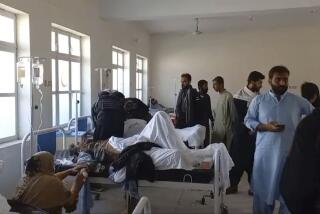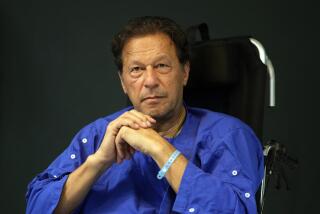Population Explodes : Happy Veneer Hides Chaotic Ills of Karachi
- Share via
KARACHI, Pakistan — It was a typical Thursday night in one of the strangest, most deeply troubled cities in Asia.
Half the city was under curfew, as it often is these days, yet thousands of people flooded into the sprawling, seaside amusement park called Funland for a few hours of healthy recreation.
Fundamentalist Muslim women clad in black from head to foot squealed with glee as they were whipped around on a ride known as the “Red Baron.” In keeping with the traditions of this overwhelmingly Islamic nation, they struggled to keep their faces veiled.
Prayers and Roller Coaster
At precisely 6 p.m., scores of bearded men stopped whatever they were doing and gathered beneath the roller coaster, the “Tornado,” where, oblivious to the screams and flashing lights above, they spread their rugs and made their evening prayers to Allah.
In a corner of the park, long lines formed outside the principal attraction, a Pakistan International Airlines Boeing 737 that in 1981 was hijacked by terrorists. For four rupees, about a quarter, one could board the plane and watch 10 minutes of comedy skits.
But just beneath this happy veneer, there is trouble these days, even in Funland.
Youths roam the park’s grounds selling heroin at bargain rates. Pickpockets are everywhere, and not a police officer is to be seen. Even though the rides are cheap, only about 5% of Karachi’s people can afford them. And in hopelessly overcrowded Karachi it is only at Funland and the colonial-era zoo that the people can find escape from the crime, violence and economic despair.
Unlike most international port cities, Karachi has no bars or brothels. They were banned in 1977 under pressure from the fundamentalists, who also forced the closure of a huge seafront casino.
But there is plenty of zany urban chaos, and an irrepressible instinct for survival that places Karachi among the most confounding cities on Earth.
In 1947, when India was partitioned and Pakistan was created as an independent Islamic state, there were only 350,000 people in Karachi. Today there are 8 million.
Inundated by Muslims fleeing Hindu-dominated India and since then by peasants pursuing prosperity, the city has grown from a fishing village scattered on a few islands at the mouth of the Indus River to a teeming, 1,000-square-mile checkerboard of urban sprawl and blight.
3,000 to the Square Mile
Its population density, nearly 3,000 people for every square mile, places Karachi among the most crowded cities in the world. As a result, 43% of the population lives in squatter slums, shanty towns of mud and stone built on land the government had earmarked for public schools, hospitals and recreation areas.
So acute is the land shortage, according to Karachi’s top civilian official, Commissioner Shahid Aziz Siddiq, that “the battle for Karachi is really a battle over the land bank of Karachi.”
But land and housing are not the only commodities in short supply. Because of the city’s rapid, helter-skelter growth, there are acute shortages of water, power, schools, hospital beds and telephone lines, even policemen.
Every day, the water supply falls 50 million gallons short of what is needed. The shortage of electric power is 20 million megawatts a day. There are 250,000 households waiting for telephone connections, and the ratio of police to people--1 to 455--is worse than the combined figure for New York and New Delhi. Even Dhaka, the capital of impoverished Bangladesh, has a higher ratio of police to people.
Much Traffic, Few Roads
There are not nearly enough roads. Ancient camel carts, cows and donkeys compete with buses, motorized rickshaws and late-model Japanese cars in dizzying traffic jams.
Worse, Karachi ranks among the world’s most violent cities. Its rapid growth attracted a mixed bag of ethnic, linguistic and sectarian groups from throughout the subcontinent, all competing for jobs and political power. Every week, somewhere in the city, violence flares between the various groups. Only an army-enforced curfew has brought it under control. Parts of Karachi have been under curfew for more than 125 days this year.
“There is tremendous psychological and physical pressure on people during curfew,” Abdul Sattar Edhi, a social worker, said the other day.
Sattar Edhi, who is known as “the Angel of Mercy,” runs a charitable network of ambulances, clinics and orphanages that constitute the only semblance of organized welfare and emergency care in Karachi.
‘It’s the Poor Who Pay’
“Under curfew,” he said, “no one can work or buy food. The daily wage earners are near starvation. And it is always the poor who pay most dearly for this ethnic violence.”
Compounding the crime problem is Karachi’s emergence in the past decade as one of the world’s heroin capitals. In 1980, heroin was unknown here. Not a single addict lived in the city. But now city officials estimate that there are half a million addicts, and Karachi has become a major transshipment point for heroin bound for the United States and Europe from Afghanistan and Pakistan.
Eight years of war in neighboring Afghanistan provided Karachi with a massive arsenal of illegal weapons, making it one of the world’s most heavily armed cities. Through Pakistan, the CIA supplied Afghan rebels with about $2-billion worth of weapons, and many of those weapons were diverted into Pakistani hands. Now, Commissioner Siddiq said, the increasingly militant ethnic groups and drug syndicates headquartered in Karachi and Sind province are better armed than the police.
‘It Stopped Melting’
Idress Bakhtiar, a lifelong resident of the city and a reporter for the afternoon newspaper, the Star, said: “Karachi has become a city of mafias. There are gun mafias, drug mafias, land-grabbing mafias, even beggar mafias. Karachi was supposed to be a melting pot for the Pakistani nation, but the problem is, it stopped melting, and everyone started fighting each other.”
The almost constant unrest is grounded in the disparity of poverty and wealth, the vast gap between a handful of rich and the impoverished masses.
It is generally estimated that about 4% of the city’s residents control more than 80% of its wealth. In the richest neighborhoods, the signs of wealth are as extreme as the crushing poverty that has filled the squalid, garbage-strewn slums nearby with malnourished children, raw sewage and unattended psychotics.
The most fashionable addresses are in the districts known as Clifton and Defense, and the latest architectural craze is the pillared mansion modeled on the White House in Washington. Dozens of buildings on this pattern have sprung up in the past two years. In one such house, owned by a textile mogul, there is a huge French Renaissance-style fountain, half a million dollars’ worth of mirrored walls and a master bedroom dominated by pink velvet.
Along the palm-lined streets of Clifton and Defense are shops that offer computer games and video rentals, silks and fine furnishings. But just 50 yards from the entrance to Clifton, a man named Raz Mohammed and about 60 other full-time scavengers are in the garbage business.
Raz, a recent arrival from war-torn Afghanistan, lives in a squatter colony adjacent to Clifton. He spends his days picking through the garbage of the rich. He sorts paper, plastic, tin and glass, and supports a family of five on the equivalent of a dollar a day. His family’s shanty is half the size of a Clifton bathroom.
Outside of Raz’s reeking garbage shed, with the palaces and mansions of Clifton forming a backdrop, half-naked children with distended bellies fly hand-made kites and play in the mud with broken dolls and toys made from discarded bicycle spokes.
Enormous Contradictions
“Yes,” Siddiq said, “the contradictions of my city appear to be enormous. But you must understand that all the contradictions of Karachi have been based on the lack of amenities, the lack of resources, and the fact that the fraternal bond here is very weak.
“But I don’t agree with the critics who say my city is simply out of control. The courts do operate. The mail is delivered every day. It’s more the Calcutta syndrome here. There are a lot of poor people, and people turn to violence often to make their point.”
Also like Calcutta, Karachi suffers from the former-national-capital syndrome. Karachi was Pakistan’s capital until the planned city of Islamabad was built, starting in 1960, to replace it. Since then, Karachi’s share of federal funds has been radically reduced.
But Siddiq--and even his city’s harshest critics join with him--points with pride to Karachi’s resilience, its ability to survive and even flourish despite the difficulties.
“It is a new city, a sprawling, huge, maddening conglomeration of humanity, but it is throbbing with vitality,” Siddiq said. “I find the resilience of Karachi remarkable. My city is one of very sharp contrasts. Curfew can be there, people can be getting killed left and right by the score, and yet, if you’re not standing right there, you won’t even know it’s happening.”
Witness the scene, Siddiq said, at Funland at the height of the recent ethnic violence that left 60 dead, hundreds injured and half the city under military curfew for more than a week. On that same day, the Karachi zoo, which was built by the British when Karachi was a sleepy resort for British soldiers, was packed with families seemingly oblivious to the carnage taking place elsewhere in the city.
Still, even at the zoo and at Funland, there were subtle reminders of the city’s social ills. At the monkey cage, someone had put up a handbill bearing the photograph of a boy. He was identified as a heroin addict who had run away from home, and his mother was desperately seeking information about him. At Funland, a poster sought information about a young girl who was last seen six days earlier, during the rioting.
Is there a solution to all this?
Siddiq, who has a master’s degree in sociology and political science from Cambridge University, said that “of course there is a solution.”
“Aside from massive new resources,” he said, “we need to rebuild that bond of brotherhood and fraternity. At the moment, Karachi is surviving, but if it is to continue to survive, we must all learn to live not just close together but as close as brothers.”
More to Read
Sign up for Essential California
The most important California stories and recommendations in your inbox every morning.
You may occasionally receive promotional content from the Los Angeles Times.













